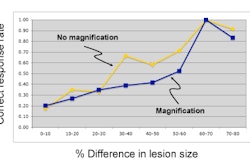SAN ANTONIO - As institutions contemplate acquisition of electronic medical record (EMR) systems, it's essential that imaging departments be involved in the selection process, according to a presentation at the Digital Healthcare Information Management Systems (DHIMS) 2008 meeting.
"This vision of radiology starting in the enterprise and ending in the enterprise is clearly going to be optimized if (imaging) is involved in that selection," said Dr. Kevin McEnery, a professor of radiology at the M. D. Anderson Cancer Center in Houston. "And optimizing image distribution really does aid in that filmless transition."
McEnery spoke during a talk on Thursday at the meeting, which is sponsored by the University of Rochester School of Medicine and Dentistry in Rochester, NY.
EMRs are an integral component to the filmless transition process, with the goal of having images integrated into both the inpatient and outpatient clinical workflow. To achieve EMR success, institutions can make use of lessons learned during PACS adoption, according to McEnery. And if you've had a successful PACS implementation, that's probably a good indication your institution is either considering an EMR or an electronic health record (EHR) system.
Most successful PACS installations have begun with small initial pilots, followed by a continual increase in overall utilization and workflow dependency, according to McEnery.
"We as an imaging community can add a lot to the overall healthcare community by looking at our PACS success in terms of EMR success," he said.
By contributing to the EMR system selection process, departments can ensure that imaging display capabilities are part of the selection criteria, McEnery said. It's also important to make sure that the selection team understands the current PACS direction.
When selecting an EMR system, demonstrated compatibility with an existing PACS is key, he said. In most cases, EMR systems are compatible, but verification is still needed.
Some PACS issues to be aware of in the EMR selection process include finding out how images will be made available in the EMR system, and if the EMR vendor has experience with integration, McEnery said. Institutions should also find out how physician orders will be transmitted to the RIS/PACS, and if imaging decision support will be incorporated into the EMR system.
It's also important to confirm that your current PACS vendor has an enterprise-distribution capability, and if that functionality can be integrated into the EMR system, he noted. Also, find out which EMR vendors have integrated with your current PACS vendor at sites similar to your own, McEnery said. In addition, imaging decision makers should have input into key features of order entry.
Order entry can be beneficial in a number of ways, adding capabilities such as automated precertification, complete clinical documentation, and better transfer of clinical information to the radiologist, he said. Results communication also needs to be discussed, determining how imaging results will be accessed by clinicians, McEnery said.
By Erik L. Ridley
AuntMinnie.com staff writer
March 28, 2008
Related Reading
Planning eases PACS upgrade woes, vendor changes, March 27, 2008
Part XVIII: Exploring PACS Secrets -- Hiding out in plain view: PACS at HIMSS, March 10, 2008
Finland on track to completing national EMR archive, March 8, 2008
Standards drive Australian e-health initiative, March 16, 2007
EHR deployment presents familiar obstacles, February 27, 2007
Copyright © 2008 AuntMinnie.com




















